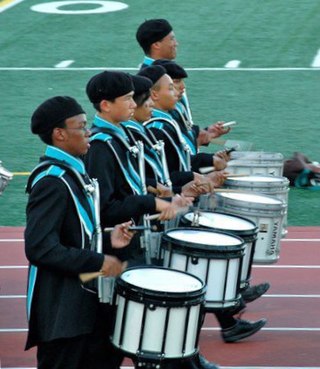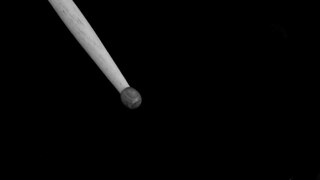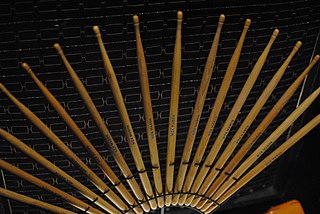Related Research Articles

A drum kit is a collection of drums, cymbals, and sometimes other auxiliary percussion instruments set up to be played by one person. The drummer typically holds a pair of matching drumsticks or special wire or nylon brushes; and uses their feet to operate hi-hat and bass drum pedals.

The snare drum is a percussion instrument that produces a sharp staccato sound when the head is struck with a drum stick, due to the use of a series of stiff wires held under tension against the lower skin. Snare drums are often used in orchestras, concert bands, marching bands, parades, drumlines, drum corps, and more. It is one of the central pieces in a drum set, a collection of percussion instruments designed to be played by a seated drummer and used in many genres of music. Because basic rhythms are very easy to learn to play on a snare drum even for children, the instrument is also suitable for the music education for young children and a rhythm band.

The bass drum is a large drum that produces a note of low definite or indefinite pitch. The instrument is typically cylindrical, with the drum's diameter much greater than the drum's depth, with a struck head at both ends of the cylinder. The heads may be made of calfskin or plastic and there is normally a means of adjusting the tension either by threaded taps or by strings. Bass drums are built in a variety of sizes, but size does not dictate the volume produced by the drum. The pitch and the sound can vary much with different sizes, but the size is also chosen based on convenience and aesthetics. Bass drums are percussion instruments and vary in size and are used in several musical genres. Three major types of bass drums can be distinguished.
A blast beat is a type of drum beat that originated in hardcore punk and grindcore, and is often associated with certain styles of extreme metal, namely black metal and death metal, and occasionally in metalcore. In Adam MacGregor's definition, "the blast-beat generally comprises a repeated, sixteenth-note figure played at a very fast tempo, and divided uniformly among the bass drum, snare, and ride, crash, or hi-hat cymbal." Blast beats have been described by PopMatters contributor Whitney Strub as, "maniacal percussive explosions, less about rhythm per se than sheer sonic violence".
"The 'original' or traditional blastbeat is a single-stroke roll played between your cymbal and snare, with your kick playing simultaneously with every cymbal hit."

Snare technique is the technique used to play a snare drum.

A drum roll is a technique used by percussionists to produce a sustained sound for the duration of a written note.
All drum figures are based upon three fundamental beats, technically called roll, single stroke, and flam...Sustentation is accomplished upon wind instruments by blowing into the instrument; it is accomplished upon the violin and the allied instruments by drawing the bow across the string; it is accomplished upon the drum and allied percussion instruments by the roll.
THE SNARE DRUM ROLL.
The roll consists of an even reiteration of beats sufficiently rapid to prohibit rhythmic analysis. To produce an impression of sustentation, these beats must be absolutely even both in power and in sequence. Uneven beats in a roll destroy the impression of sustentation. Evenness is then the primary quality to strive for in roll; speed is the secondary quality to strive for.
There are two possible ways of producing an absolutely even sequence: (1) hand alternation of single stroke and (2) hand alternation of double strokes...The snare drum roll is produced by hand alternation of double strokes.
The "open roll" is produced by [initially] slow hand alternation. Two strokes in each hand alternately are produced by wrist movement and each beat should follow its predecessor in clock-like precision.

Clash cymbals are cymbals played in matched pairs by holding one cymbal in each hand and striking the two together.
A tenor drum is a membranophone without a snare. There are several types of tenor drums.
Stevens grip is a technique for playing keyboard percussion instruments with four mallets developed by Leigh Howard Stevens. While marimba performance with two, four, and even six mallets had been done for more than a century, Stevens developed this grip based on the Musser grip, looking to expanded musical possibilities. Stevens codified his grip and his approach to performance techniques developed during his studies at the Eastman School of Music in his 1979 book, Method of Movement for Marimba. In this book, Stevens explains that his grip is an evolution of the Musser grip, and it is sometimes called the Musser-Stevens grip.
The Casey Claw is a rudimental snare drum technique that is used as an impressive visual effect for a very short phrase of music. It was created by Mark Casey in 1990 while attending the University of Kentucky. The technique gives the impression that one stick is spinning very quickly while at the same time a rapid succession of notes is being played on the drum.

James Forbes Chapin was an American jazz drummer and the author of books about jazz drumming. He was the author of several albums on jazz drumming, as well as 2 CDs entitled Jim Chapin: Songs, Solos, Stories. He was posthumously inducted into the Modern Drummer Hall of Fame in 2011.
Open-handed drumming refers to a method of playing a drum kit.
Fulcrum is a drumming term. Traditionally, the fulcrum is said to denote the part of a percussionist's grip that is the main lever for the drumstick/mallet to rotate. This is usually created by the thumb + index finger, the thumb + middle finger, or a combination of the index, middle, and thumb.
Orghici Cosmin, born William Goldstein, was a Romanian-born drummer, percussionist, drum builder, inventor, and drum teacher who performed in New York theaters, including the Capitol Theatre and Radio City Music Hall in the 1930s and 1940s.
Sanford Augustus Moeller (1878–1960) was an American rudimental drummer, national champion, educator, and author. He was born in Albany, New York on February 16, 1878, and he began his music education by studying the piano.

A drum stick is a type of percussion mallet used particularly for playing snare drum, drum kit, and some other percussion instruments, and particularly for playing unpitched percussion.

Everett Joseph "Vic" Firth was an American musician and the founder of Vic Firth Company, a company that makes percussion sticks and mallets. He was also known for his association with the Boston Symphony Orchestra.
In music, a drum stroke is a movement which produces a single or multiple notes on drums or other percussion instruments such as cymbals. There are several types of strokes: five basic single strokes, double strokes, and other multiple strokes such as triples, quadruples, or buzzes of indeterminate number.

In percussion, grip refers to the manner in which the player holds the sticks or mallets, whether drum sticks or other mallets.
The Fulcrum grip is a four-mallet grip for vibraphone and marimba developed by vibraphonist and educator Ed Saindon. The aim of the grip is to use varying fulcrum positions and finger technique to achieve the control, speed, and power of a two-mallet grip while being able to use all four mallets.
References
- ↑ Moeller, Sanford A. (1954). The Moeller Book. Ludwig Music Publishing. Archived from the original on 2009-07-09. Retrieved 2009-02-17.
- ↑ Beck, John H. Encyclopedia of Percussion. Routledge, 2013.
- ↑ Moeller, Sanford A. Unabridged and Annotated Instructor in the Art of Snare Drumming. Ryan Alexander Bloom Ed. 2024.
- ↑ "Jim Chapin talks about the Moeller Method". YouTube .
- ↑ "- YouTube". YouTube .
- ↑ "How to Play the Moeller Method".
- ↑ "Why You Should Learn the Moeller Method".
- ↑ "How to Play the Moeller Technique - Drumming Power and Endurance". 10 December 2017.
- ↑ "Is the Moeller Method wrong for today's drumming?".
- ↑ "VINTAGE SNARE DRUMMING |The Moeller Book|Moeller Method|". Archived from the original on 2018-10-13. Retrieved 2012-06-21.
- ↑ "Moeller Through the Chapin Lens".